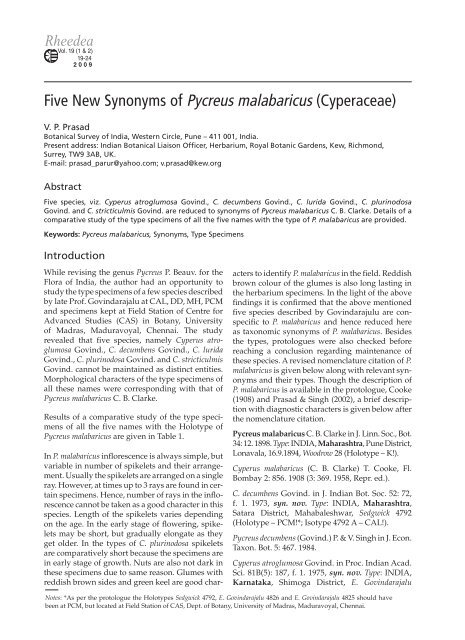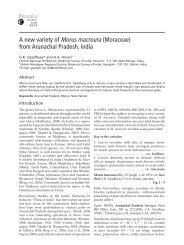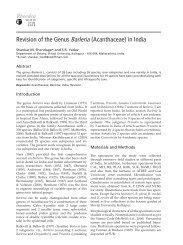Five New Synonyms of Pycreus malabaricus (Cyperaceae) - Iaat.org.in
Five New Synonyms of Pycreus malabaricus (Cyperaceae) - Iaat.org.in
Five New Synonyms of Pycreus malabaricus (Cyperaceae) - Iaat.org.in
You also want an ePaper? Increase the reach of your titles
YUMPU automatically turns print PDFs into web optimized ePapers that Google loves.
Rheedea<br />
Vol. 19 (1 & 2)<br />
19-24<br />
2009<br />
<strong>Five</strong> <strong>New</strong> <strong>Synonyms</strong> <strong>of</strong> <strong>Pycreus</strong> <strong>malabaricus</strong> (<strong>Cyperaceae</strong>)<br />
V. P. Prasad<br />
Botanical Survey <strong>of</strong> India, Western Circle, Pune – 411 001, India.<br />
Present address: Indian Botanical Liaison Officer, Herbarium, Royal Botanic Gardens, Kew, Richmond,<br />
Surrey, TW9 3AB, UK.<br />
E-mail: prasad_parur@yahoo.com; v.prasad@kew.<strong>org</strong><br />
Abstract<br />
<strong>Five</strong> species, viz. Cyperus atroglumosa Gov<strong>in</strong>d., C. decumbens Gov<strong>in</strong>d., C. lurida Gov<strong>in</strong>d., C. plur<strong>in</strong>odosa<br />
Gov<strong>in</strong>d. and C. stricticulmis Gov<strong>in</strong>d. are reduced to synonyms <strong>of</strong> <strong>Pycreus</strong> <strong>malabaricus</strong> C. B. Clarke. Details <strong>of</strong> a<br />
comparative study <strong>of</strong> the type specimens <strong>of</strong> all the five names with the type <strong>of</strong> P. <strong>malabaricus</strong> are provided.<br />
Keywords: <strong>Pycreus</strong> <strong>malabaricus</strong>, <strong>Synonyms</strong>, Type Specimens<br />
Introduction<br />
While revis<strong>in</strong>g the genus <strong>Pycreus</strong> P. Beauv. for the<br />
Flora <strong>of</strong> India, the author had an opportunity to<br />
study the type specimens <strong>of</strong> a few species described<br />
by late Pr<strong>of</strong>. Gov<strong>in</strong>darajalu at CAL, DD, MH, PCM<br />
and specimens kept at Field Station <strong>of</strong> Centre for<br />
Advanced Studies (CAS) <strong>in</strong> Botany, University<br />
<strong>of</strong> Madras, Maduravoyal, Chennai. The study<br />
revealed that five species, namely Cyperus atroglumosa<br />
Gov<strong>in</strong>d., C. decumbens Gov<strong>in</strong>d., C. lurida<br />
Gov<strong>in</strong>d., C. plur<strong>in</strong>odosa Gov<strong>in</strong>d. and C. stricticulmis<br />
Gov<strong>in</strong>d. cannot be ma<strong>in</strong>ta<strong>in</strong>ed as dist<strong>in</strong>ct entities.<br />
Morphological characters <strong>of</strong> the type specimens <strong>of</strong><br />
all these names were correspond<strong>in</strong>g with that <strong>of</strong><br />
<strong>Pycreus</strong> <strong>malabaricus</strong> C. B. Clarke.<br />
Results <strong>of</strong> a comparative study <strong>of</strong> the type specimens<br />
<strong>of</strong> all the five names with the Holotype <strong>of</strong><br />
<strong>Pycreus</strong> <strong>malabaricus</strong> are given <strong>in</strong> Table 1.<br />
In P. <strong>malabaricus</strong> <strong>in</strong>florescence is always simple, but<br />
variable <strong>in</strong> number <strong>of</strong> spikelets and their arrangement.<br />
Usually the spikelets are arranged on a s<strong>in</strong>gle<br />
ray. However, at times up to 3 rays are found <strong>in</strong> certa<strong>in</strong><br />
specimens. Hence, number <strong>of</strong> rays <strong>in</strong> the <strong>in</strong>florescence<br />
cannot be taken as a good character <strong>in</strong> this<br />
species. Length <strong>of</strong> the spikelets varies depend<strong>in</strong>g<br />
on the age. In the early stage <strong>of</strong> flower<strong>in</strong>g, spikelets<br />
may be short, but gradually elongate as they<br />
get older. In the types <strong>of</strong> C. plur<strong>in</strong>odosa spikelets<br />
are comparatively short because the specimens are<br />
<strong>in</strong> early stage <strong>of</strong> growth. Nuts are also not dark <strong>in</strong><br />
these specimens due to same reason. Glumes with<br />
reddish brown sides and green keel are good characters<br />
to identify P. <strong>malabaricus</strong> <strong>in</strong> the field. Reddish<br />
brown colour <strong>of</strong> the glumes is also long last<strong>in</strong>g <strong>in</strong><br />
the herbarium specimens. In the light <strong>of</strong> the above<br />
f<strong>in</strong>d<strong>in</strong>gs it is confirmed that the above mentioned<br />
five species described by Gov<strong>in</strong>darajulu are conspecific<br />
to P. <strong>malabaricus</strong> and hence reduced here<br />
as taxonomic synonyms <strong>of</strong> P. <strong>malabaricus</strong>. Besides<br />
the types, protologues were also checked before<br />
reach<strong>in</strong>g a conclusion regard<strong>in</strong>g ma<strong>in</strong>tenance <strong>of</strong><br />
these species. A revised nomenclature citation <strong>of</strong> P.<br />
<strong>malabaricus</strong> is given below along with relevant synonyms<br />
and their types. Though the description <strong>of</strong><br />
P. <strong>malabaricus</strong> is available <strong>in</strong> the protologue, Cooke<br />
(1908) and Prasad & S<strong>in</strong>gh (2002), a brief description<br />
with diagnostic characters is given below after<br />
the nomenclature citation.<br />
<strong>Pycreus</strong> <strong>malabaricus</strong> C. B. Clarke <strong>in</strong> J. L<strong>in</strong>n. Soc., Bot.<br />
34: 12. 1898. Type: INDIA, Maharashtra, Pune District,<br />
Lonavala, 16.9.1894, Woodrow 28 (Holotype – K!).<br />
Cyperus <strong>malabaricus</strong> (C. B. Clarke) T. Cooke, Fl.<br />
Bombay 2: 856. 1908 (3: 369. 1958, Repr. ed.).<br />
C. decumbens Gov<strong>in</strong>d. <strong>in</strong> J. Indian Bot. Soc. 52: 72,<br />
f. 1. 1973, syn. nov. Type: INDIA, Maharashtra,<br />
Satara District, Mahabaleshwar, Sedgwick 4792<br />
(Holotype – PCM!*; Isotype 4792 A – CAL!).<br />
<strong>Pycreus</strong> decumbens (Gov<strong>in</strong>d.) P. & V. S<strong>in</strong>gh <strong>in</strong> J. Econ.<br />
Taxon. Bot. 5: 467. 1984.<br />
Cyperus atroglumosa Gov<strong>in</strong>d. <strong>in</strong> Proc. Indian Acad.<br />
Sci. 81B(5): 187, f. 1. 1975, syn. nov. Type: INDIA,<br />
Karnataka, Shimoga District, E. Gov<strong>in</strong>darajalu<br />
Notes: *As per the protologue the Holotypes Sedgwick 4792, E. Gov<strong>in</strong>darajalu 4826 and E. Gov<strong>in</strong>darajalu 4825 should have<br />
been at PCM, but located at Field Station <strong>of</strong> CAS, Dept. <strong>of</strong> Botany, University <strong>of</strong> Madras, Maduravoyal, Chennai.
20 <strong>Five</strong> <strong>New</strong> <strong>Synonyms</strong> <strong>of</strong> <strong>Pycreus</strong> <strong>malabaricus</strong> (<strong>Cyperaceae</strong>)<br />
Table 1. Comparative study <strong>of</strong> the types <strong>of</strong> Cyperus atroglumosa Gov<strong>in</strong>d., C. decumbens Gov<strong>in</strong>d., C. lurida Gov<strong>in</strong>d., C. plur<strong>in</strong>odosa Gov<strong>in</strong>d. and C. stricticulmis<br />
Gov<strong>in</strong>d. with the Holotype <strong>of</strong> <strong>Pycreus</strong> <strong>malabaricus</strong> C. B. Clarke<br />
P. <strong>malabaricus</strong> C. decumbens C. atroglumosa C. lurida C. plur<strong>in</strong>odosa C. stricticulmis<br />
Habit Annuals Annuals Annuals Annuals Annuals. Gov<strong>in</strong>darajalu<br />
(1975) says<br />
stolons present. But<br />
only fibrous roots<br />
were found <strong>in</strong> the<br />
type specimens<br />
Annuals. Accord<strong>in</strong>g<br />
to Gov<strong>in</strong>darajalu<br />
(1975) stolons are<br />
present. But only<br />
fibrous roots were<br />
found <strong>in</strong> the type<br />
specimens<br />
Culms Tufted, compressed,<br />
trigonous.<br />
Tufted, compressed,<br />
trigonous<br />
Tufted, compressed,<br />
trigonous<br />
Tufted, compressed,<br />
trigonous<br />
Tufted, compressed Tufted, compressed<br />
Leaves Shorter than to as<br />
long as the culm<br />
Shorter than to as<br />
long as the culm<br />
Shorter than to as<br />
long as the culm<br />
Shorter than to as<br />
long as the culm<br />
Shorter or longer than<br />
the culm<br />
Shorter than to as<br />
long as the culm<br />
Inflorescence<br />
Simple, 1 – 3-rayed<br />
(usually 1-rayed),<br />
with 3 – 12 spikelets<br />
Simple, 1-rayed,<br />
with 3 – 5 spikelets<br />
Simple, 1 – 3-rayed,<br />
with 3 – 10 spikelets<br />
Simple, 1 or 2-rayed<br />
(not well developed <strong>in</strong><br />
the types), with 3 – 8<br />
spikelets<br />
Simple, 1 – 3-rayed,<br />
with 5 – 8 spikelets<br />
Simple, 1 – 3-rayed,<br />
with 3 – 6 spikelets<br />
Involucral<br />
bracts<br />
3, lowest much<br />
longer than the<br />
<strong>in</strong>florescence<br />
2 or 3, lowest longer<br />
than the <strong>in</strong>florescence<br />
2 or 3, longer than the<br />
<strong>in</strong>florescence<br />
2 or 3, lowest longer<br />
than the <strong>in</strong>florescence<br />
3 or 4, longer than the<br />
<strong>in</strong>florescence<br />
2 or 3, longer than<br />
the <strong>in</strong>florescence<br />
Spikelets Strongly compressed,<br />
l<strong>in</strong>earoblong,<br />
subacute at<br />
apex, 5 – 10 c. 2.5<br />
mm; rachilla w<strong>in</strong>gless<br />
Strongly compressed,<br />
l<strong>in</strong>earoblong<br />
to lanceolate,<br />
subacute at apex,<br />
6 – 8 2.2 – 2.5 mm;<br />
rachilla w<strong>in</strong>gless<br />
Strongly compressed,<br />
oblong-lanceolate,<br />
subacute at apex,<br />
7 – 10 c. 2.2 mm;<br />
rachilla w<strong>in</strong>gless.<br />
Strongly compressed,<br />
oblong-lanceolate,<br />
subacute at apex, 8<br />
– 10 2.2 – 2.5 mm;<br />
rachilla w<strong>in</strong>gless<br />
Strongly compressed,<br />
oblong-lanceolate,<br />
subacute at apex,<br />
5 – 6 2.2 – 2.5 mm;<br />
rachilla w<strong>in</strong>gless<br />
Strongly compressed,<br />
oblonglanceolate,<br />
subacute<br />
at apex, 7 – 10 <br />
c. 2.5 mm; rachilla<br />
w<strong>in</strong>gless
V. P. Prasad 21<br />
Glumes Membranaceous,<br />
densely imbricate,<br />
broadly ovate,<br />
acute and m<strong>in</strong>utely<br />
apiculate at apex,<br />
c. 2 1.5 mm, with<br />
dark reddish brown<br />
nerveless sides,<br />
sh<strong>in</strong><strong>in</strong>g, with hyal<strong>in</strong>e<br />
marg<strong>in</strong>s; keel<br />
prom<strong>in</strong>ent, green,<br />
3-nerved<br />
Stamens 2; anthers l<strong>in</strong>earoblong,<br />
c. 0.5 mm<br />
long<br />
Style 1.0 – 1.2 mm long;<br />
stigmas shorter<br />
than style<br />
Nut Biconvex, c. 1 0.8<br />
mm, broadly obovate,<br />
obtuse at apex,<br />
m<strong>in</strong>utely apiculate,<br />
ultimately dark<br />
brown, f<strong>in</strong>ely transversely<br />
undulate<br />
Membranaceous,<br />
densely imbricate,<br />
broadly ovate, acute<br />
and m<strong>in</strong>utely apiculate<br />
at apex, 1.72 <br />
c. 1.5 mm, with<br />
dark reddish brown<br />
nerveless sides and<br />
hyal<strong>in</strong>e marg<strong>in</strong>s;<br />
keel prom<strong>in</strong>ent,<br />
3-nerved<br />
2; anthers oblong,<br />
0.4 – 0.5 mm long<br />
c. 1 mm long; stigmas<br />
shorter than<br />
style<br />
Biconvex, c. 0.9 <br />
0.7 mm, broadly<br />
obovate, m<strong>in</strong>utely<br />
apiculate at apex,<br />
dark brown to blackish,<br />
transversely<br />
undulate<br />
Membranaceous,<br />
densely imbricate,<br />
broadly ovate, acute<br />
and m<strong>in</strong>utely apiculate<br />
at apex, 1.8 – 2 <br />
c. 1.5 mm, with dark<br />
reddish brown nerveless<br />
sides, sh<strong>in</strong><strong>in</strong>g,<br />
with hyal<strong>in</strong>e marg<strong>in</strong>s;<br />
keel prom<strong>in</strong>ent,<br />
3-nerved<br />
2; anthers l<strong>in</strong>ear-oblong,<br />
c. 0.5 mm long<br />
c. 1 mm long; stigmas<br />
shorter than style<br />
Biconvex, c. 1 0.7<br />
mm, broadly ellipticobovate,<br />
apiculate at<br />
apex, dark brown to<br />
blackish, transversely<br />
undulate<br />
Membranaceous,<br />
densely imbricate,<br />
broadly ovate, acute<br />
and m<strong>in</strong>utely apiculate<br />
at apex, c. 2 1.5<br />
mm, with dark reddish<br />
brown nerveless<br />
sides, sh<strong>in</strong><strong>in</strong>g, with<br />
hyal<strong>in</strong>e marg<strong>in</strong>s; keel<br />
prom<strong>in</strong>ent, 3-nerved<br />
2; anthers oblong, c.<br />
0.5 mm long<br />
c. 1 mm long; stigmas<br />
shorter than style<br />
Biconvex, c. 1 0.8<br />
mm, broadly ellipticobovate,<br />
m<strong>in</strong>utely apiculate<br />
at apex, dark<br />
brown to blackish,<br />
sh<strong>in</strong><strong>in</strong>g, transversely<br />
undulate<br />
Membranaceous,<br />
densely imbricate,<br />
broadly ovate, acute<br />
and m<strong>in</strong>utely apiculate<br />
at apex, c. 2 <br />
1.5 mm, with dark<br />
reddish brown nerveless<br />
sides and hyal<strong>in</strong>e<br />
marg<strong>in</strong>s; keel prom<strong>in</strong>ent,<br />
3-nerved<br />
2; anthers l<strong>in</strong>earoblong,<br />
0.5 – 0.6 mm<br />
long.<br />
c. 1 mm long; stigmas<br />
shorter than style<br />
Biconvex, c. 1 0.7<br />
mm, broadly obovate,<br />
m<strong>in</strong>utely apiculate<br />
at obtuse apex, yellowish<br />
turn<strong>in</strong>g dark<br />
brown, fa<strong>in</strong>tly transversely<br />
undulate<br />
Membranaceous,<br />
densely imbricate,<br />
broadly ovate, acute<br />
and m<strong>in</strong>utely apiculate<br />
at apex, 2 – 2.2<br />
1.5 – 1.8 mm, with<br />
dark reddish brown<br />
nerveless sides, sh<strong>in</strong><strong>in</strong>g,<br />
with hyal<strong>in</strong>e<br />
marg<strong>in</strong>s; keel prom<strong>in</strong>ent,<br />
3-nerved<br />
2; anthers l<strong>in</strong>earoblong,<br />
05 – 0.6 mm<br />
long<br />
1.0 – 1.2 mm long;<br />
stigmas shorter than<br />
style<br />
Biconvex, 1 – 1.1<br />
0.8 – 0.9 mm,<br />
broadly ellipticobovate,<br />
m<strong>in</strong>utely<br />
apiculate at apex,<br />
dark brown to<br />
blackish, sh<strong>in</strong><strong>in</strong>g,<br />
fa<strong>in</strong>tly transversely<br />
undulate
22 <strong>Five</strong> <strong>New</strong> <strong>Synonyms</strong> <strong>of</strong> <strong>Pycreus</strong> <strong>malabaricus</strong> (<strong>Cyperaceae</strong>)<br />
Figure 1. a. <strong>Pycreus</strong> <strong>malabaricus</strong> C. B. Clarke; b – d. Holotypes <strong>of</strong> Cyperus decumbens Gov<strong>in</strong>d., C. atroglumosa<br />
Gov<strong>in</strong>d. and C. lurida Gov<strong>in</strong>d.
Figure 2. a, b. Holotypes <strong>of</strong> Cyperus plur<strong>in</strong>odosa Gov<strong>in</strong>d. and C. stricticulmis Gov<strong>in</strong>d.; c. Spikelets <strong>of</strong> <strong>Pycreus</strong><br />
<strong>malabaricus</strong> C. B. Clarke; d – h. Spikelets <strong>of</strong> the Holotypes <strong>of</strong> Cyperus decumbens Gov<strong>in</strong>d., C. atroglumosa<br />
Gov<strong>in</strong>d., C. lurida Gov<strong>in</strong>d., C. plur<strong>in</strong>odosa Gov<strong>in</strong>d. and C. stricticulmis Gov<strong>in</strong>d.<br />
V. P. Prasad 23
24 <strong>Five</strong> <strong>New</strong> <strong>Synonyms</strong> <strong>of</strong> <strong>Pycreus</strong> <strong>malabaricus</strong> (<strong>Cyperaceae</strong>)<br />
4826 (Holotype – PCM!*); Megaravalli to Nalur,<br />
7.10.1961, E. Gov<strong>in</strong>darajalu 4823 (Paratype – CAL!);<br />
4823A (Paratype – BSI! † ); Agumbi (Agumbe),<br />
19.10.1961, P. Jayaraman 2819 (Paratype – PCM!);<br />
Emmekalkere, 10.10.1961, E. Gov<strong>in</strong>darajalu 5001<br />
(Paratype – MH! ♦ ); 5001A (Paratype – BLAT! ✪ );<br />
between Guddakeri and Nalur, 13.10.1961,<br />
E. Gov<strong>in</strong>darajalu 5187 (Paratype – DD!).<br />
<strong>Pycreus</strong> atroglumosus (Gov<strong>in</strong>d.) P. & V. S<strong>in</strong>gh <strong>in</strong><br />
J. Econ. Taxon. Bot. 5: 467. 1984.<br />
Cyperus lurida Gov<strong>in</strong>d. <strong>in</strong> Proc. Indian Acad. Sci. 81<br />
B(5): 189, f. 2. 1975, syn. nov. Type: INDIA, Tamil<br />
Nadu, Coimbatore District, Valparai, Akkamalai,<br />
3.1.1971, E. Gov<strong>in</strong>darajalu 10742 (Holotype – PCM! ‡ ;<br />
Isotypes 10742 F – CAL, 10742 D – DD, 10742 H –<br />
PCM).<br />
<strong>Pycreus</strong> lurida (Gov<strong>in</strong>d.) P. & V. S<strong>in</strong>gh <strong>in</strong> J. Econ.<br />
Taxon. Bot. 5: 467. 1984.<br />
Cyperus plur<strong>in</strong>odosa Gov<strong>in</strong>d. <strong>in</strong> Proc. Indian Acad.<br />
Sci. 81B(5): 192, f. 3. 1975, syn. nov. Type: INDIA,<br />
Karnataka, Shimoga District, Megaravalli to<br />
Nalur, 7.10.1961, E. Gov<strong>in</strong>darajalu 4825 (Holotype<br />
– PCM!*).<br />
<strong>Pycreus</strong> plur<strong>in</strong>odosus (Gov<strong>in</strong>d.) P. & V. S<strong>in</strong>gh <strong>in</strong><br />
J. Econ. Taxon. Bot. 5: 467. 1984.<br />
Cyperus stricticulmis Gov<strong>in</strong>d. <strong>in</strong> Proc. Indian Acad.<br />
Sci. 81B(5): 194, f. 4. 1975, syn. nov. Type: INDIA, Tamil<br />
Nadu, Coimbatore District, Valparai, 7.10.1968,<br />
E. Gov<strong>in</strong>darajalu 9042 (Holotype – PCM!; Isotypes –<br />
CAL!, MH!).<br />
<strong>Pycreus</strong> stricticulmis (Gov<strong>in</strong>d.) P. & V. S<strong>in</strong>gh <strong>in</strong><br />
J. Econ. Taxon. Bot. 5: 467. 1984.<br />
Annuals with tufted slender stems, 13 – 35 cm<br />
high. Leaves shorter than or as long as the stem.<br />
Inflorescence simple, with 5 – 12 spikelets. Involucral<br />
bracts 3; lowest much overtopp<strong>in</strong>g the<br />
<strong>in</strong>florescence. Spikelets strongly compressed, 5 –<br />
10 2.2 – 2.5 mm, l<strong>in</strong>ear-oblong, subacute at<br />
apex, 14 – 20-flowered; rachilla straight, w<strong>in</strong>gless.<br />
Glumes densely imbricate, c. 2 1.5 mm,<br />
broadly ovate, acute at apex, dark and sh<strong>in</strong><strong>in</strong>g<br />
reddish brown, with white-hyal<strong>in</strong>e marg<strong>in</strong>; keel<br />
green. Stamens 2; anthers c. 0.5 mm long, l<strong>in</strong>earoblong.<br />
Stigmas 2, slightly shorter than style.<br />
Nut laterally compressed, biconvex, c. 1 0.7 –<br />
0.9 mm, globose-obovoid, m<strong>in</strong>utely apiculate at<br />
the obtuse apex, <strong>of</strong>ten slightly asymmetric near<br />
base, ultimately dark brown, fa<strong>in</strong>tly transversely<br />
undulate.<br />
Flower<strong>in</strong>g & Fruit<strong>in</strong>g: August – January.<br />
Distribution: Found <strong>in</strong> moist rocky areas and wet<br />
gravelly soil, especially towards the coastal areas.<br />
Endemic to Pen<strong>in</strong>sular India.<br />
Acknowledgements<br />
The author is thankful to Dr. M. Sanjappa, Director,<br />
Botanical Survey <strong>of</strong> India (BSI), Kolkata and<br />
Dr. P. G. Diwakar, Jo<strong>in</strong>t Director, BSI, Pune, for the<br />
facilities; Dr. S. Karthikeyan, Ex-Deputy Director,<br />
BSI, Pune, for the helpful suggestions after<br />
go<strong>in</strong>g through the manuscript. Thanks are due to<br />
the follow<strong>in</strong>g persons and Institutes for permitt<strong>in</strong>g<br />
to consult their herbaria. The Director, Forest<br />
Research Institute, Dehra Dun; Pr<strong>of</strong>. N. Anand,<br />
Director, CAS, Dept. <strong>of</strong> Botany, University <strong>of</strong><br />
Madras, Chennai; Dr. S. Amerjothy, Head, Department<br />
<strong>of</strong> Post Graduate & Research Studies <strong>in</strong><br />
Botany, Presidency College, Chennai and Dr.<br />
G. V. S. Murthy, Jo<strong>in</strong>t Director, BSI, Coimbatore.<br />
Image <strong>of</strong> the Holotype <strong>of</strong> <strong>Pycreus</strong> <strong>malabaricus</strong> C. B.<br />
Clarke is reproduced with k<strong>in</strong>d permission <strong>of</strong> the<br />
Director and the Board <strong>of</strong> Trustees, Royal Botanic<br />
Gardens, Kew, UK.<br />
Literature Cited<br />
Cooke, T. 1908 (Repr. ed. 1958). The Flora <strong>of</strong> the<br />
Presidency <strong>of</strong> Bombay. Botanical Survey <strong>of</strong> India,<br />
Kolkata. p. 369.<br />
Prasad, V. P. & N. P. S<strong>in</strong>gh 2002. Sedges <strong>of</strong> Karnataka<br />
(India). (Repr<strong>in</strong>ted from J. Econ. Taxon.<br />
Bot. Addl. Ser. No. 21). Scientific Publishers,<br />
Jodhpur. pp. 275 – 276.<br />
Received: 7.7.2008<br />
Revised and Accepted: 10.8.2009<br />
Notes: *As per the protologue the Holotypes Sedgwick 4792, E. Gov<strong>in</strong>darajalu 4826 and E. Gov<strong>in</strong>darajalu 4825 should have been at<br />
PCM, but located at Field Station <strong>of</strong> CAS, Dept. <strong>of</strong> Botany, University <strong>of</strong> Madras, Maduravoyal, Chennai.<br />
† As per the protologue the Paratype E. Gov<strong>in</strong>darajalu 4823 A should have been at BSI, but located at PCM, Chennai.<br />
♦As per the protologue the Paratype E. Gov<strong>in</strong>darajalu 5001 should have been at MH, but located at PCM, Chennai.<br />
✪ As per the protologue the Paratype E. Gov<strong>in</strong>darajalu 5001A should have been at BLAT, Mumbai, but located at PCM, Chennai.<br />
‡ As per the protologue the Holotype E. Gov<strong>in</strong>darajalu 10742 should have been at PCM, but located at Field Station <strong>of</strong> CAS, Dept. <strong>of</strong><br />
Botany, University <strong>of</strong> Madras, Maduravoyal, Chennai.












